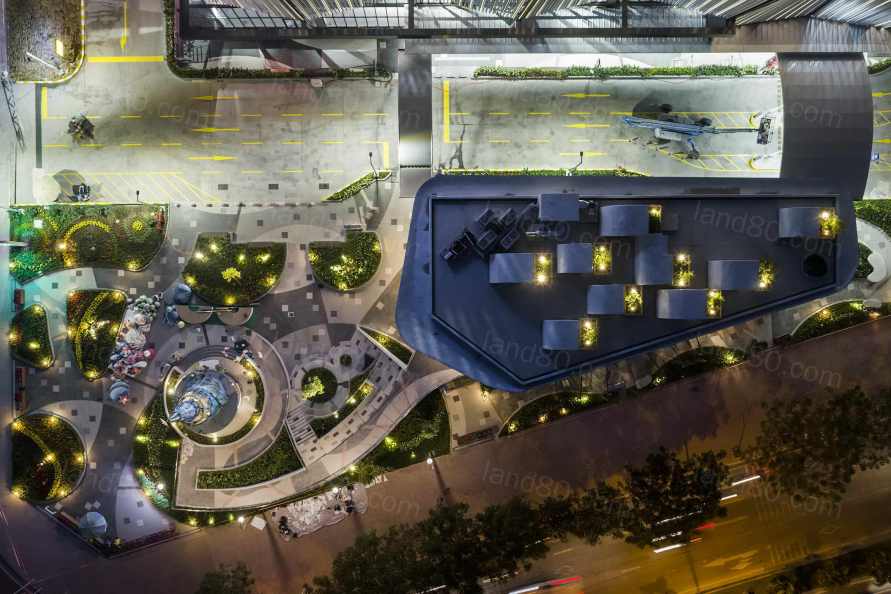Pizza 4P's店的一座方舟
海防市是位于红河口的港口城市,距离河内约100公里,这里有越南北部最大的码头港口,是一个物流和工业中心。该项目被命名为 "Pizza 4P's的方舟馆",被设计为一座独立的建筑,位于一个新建的大型购物中心。这个项目被设想为一个象征性的纪念碑,既能体现城市和餐厅的独特背景和价值,即海防作为一个港口和工业城市,也能体现Pizza 4P的可持续餐饮价值。该建筑被感知为停靠在港口的方舟,而大型购物中心则代表了这一点。它是一座方舟馆,在这里,城市的历史和记忆被拥抱并展示给食客和游客。
Ark pavilion for Pizza 4P's
Hai Phong is a logistics and industrial hub with the largest terminal port in Northern Vietnam. It is a port city at the mouth of the Red River, about 100km away from Hanoi. The project, named “Ark Pavilion for Pizza 4P’s” is designed as a standalone building at the corner of a large newly built shopping mall. This project is conceived as a symbolic monument to capture both the unique background and values of the city and restaurant - Hai Phong as a port and industrial city, as well as Pizza 4P’s value of sustainable dining. The building is perceived as an ark docked in a port, which is represented by the large shopping mall. It is an ark pavilion where the history and memories of the city are embraced and displayed to the diners and visitors.

立体景观的设计手法
本项目旁边的商场是一栋巨大的三层建筑,总建筑面积约16万平方米,每天有20万人次到访。项目处于三角形用地,即商场的东南侧。设计了不同空间尺度的动态过渡,合理地引导游客从庞大的购物中心进入餐饮空间。通道被设计成立体景观。主入口位于二楼,人们通过缓缓上升到花圃来接近餐厅。随后,迎接游客的是一个高大的中庭,比一般商场的天花板高度高出1.5倍,形成了一个引人注目的餐厅入口。
An approach with a three-dimensional landscape
The shopping mall adjacent to this project is a huge three-story building with a total floor area of about 160,000 square meters, visited by 200,000 people a day. The project is in a triangular site, the Southeastern side of the mall. Dynamic transitions with varying spatial scales have been designed to sensibly guide the visitors to the dining space from the massive shopping mall. The access is designed as a three-dimensional landscape with the main entrance being located on the second floor. One approaches the restaurant by gently ascending to the flower garden. The visitors are then greeted by a tall atrium - 1.5 times higher than the typical mall’s ceiling height, creating a striking entrance to the restaurant.

在位于餐厅中心的一对披萨炉上方,9个大小不一的北向天窗为用餐区提供了柔和的自然光。每一扇窗户旁都种植了垂榕,这些树最终会长高,为建筑遮挡强烈的热带阳光。从树上射下的柔和的阳光和在微风中摇曳的树叶,给游客带来了难忘的用餐体验。傍晚时分,点亮的树木出现在虚空之上,突出了巨大的垂直空间。
Above a pair of pizza ovens located in the heart of the restaurant, 9 North-facing skylights with varying sizes provide soft and gentle natural light into the dining area. Benjamin trees are planted next to every window, which will eventually grow taller to shade the building from intense tropical sunlight. The soft and filtered sunlight from the trees and sight of leaves swaying in the breeze present visitors a memorable dining experience. In the evening, lit-up trees emerge above the void, highlighting the massive vertical space.


自然光与材料反映了海防市的城市质感
海防市拥有码头港口,有很多工业材料可以利用,通过利用这些材料与自然光共同实现了空间。游客一到这里,迎接他们的是由轻金属链制成的窗帘。入口处和用餐区被这些金属链窗帘和层层叠叠的爬山虎植物柔和地隔开,金属链还被用于外墙、栏杆和爬藤植物的支撑。这些金属链反射了来自天窗和垂直缝隙的阳光,创造了一个不断变化的自然光。照明灯具是从船坞中发现的坚固的船用照明设备中回收的。它们每个都有不同的形状,为空间带来了独特性,并以其材料的庞大性创造了一种情感氛围。
Natural light and tactile reveal materials of the city of Hai Phong
The city of Hai Phong, with its terminal port, has many industrial materials available. Space was realized by using these materials together with natural light. Upon arrival, visitors are greeted with curtains made of light metal chains. The entrance and dining area are softly separated by these metal chain curtains and layers of creeper plants. The metal chains are also used on the façade, railings, and supports for the creepers. These chains reflect the sunlight from the skylights and vertical slits, creating an ever-changing natural light. Lighting fixtures are recycled from robust marine lighting found in the dockyard. Each of them has a different shape, bringing uniqueness to space and creating an emotional atmosphere with their material massiveness.




披萨炉周围的水磨石地板上,每隔50厘米就嵌入了一个由斜切的黄铜棒组成的图案。这些图案也被应用在烤箱上,增加了复杂的细节,唤起了城市的工业氛围。上层有三种带黄铜切割的水磨石,它们嵌入整个走廊,创造出一种微妙而有趣的行走体验。
The terrazzo floor around the pizza ovens is embedded with a pattern made of diagonally cut brass rods at every 50cm interval. The pattern is also applied to the ovens, adding intricate details that evoke the industrial atmosphere in the city. The upper floor has three types of terrazzo with brass cutouts, which are embedded throughout the corridor, creating a subtle yet interesting walking experience.



炉子后面的砖砌特色墙,作为餐饮区的质感背景。当地的火砖被使用,并以简单而又动态的模式排列。这些图案会随着人们所站的位置和光线的方向而变化,就像海洋中的涟漪。沿着空隙的栏杆由三种不同的材料制成:钢板、钢链和木构件。这些从城市肌理中选取的材料,不仅提供了视觉上的体验,也提供了触觉上的体验,拉近了客人与所在之处的距离。
A brick feature wall behind the ovens acts as a textured backdrop to the dining area. Local fire bricks are used and arranged in simple yet dynamic pattern. These patterns change depending on where one stands and direction of the light, like ripples in the ocean. The railings along the void are made of three different materials: steel plates, steel chains, and wooden members. These materials, selected from the city's fabric, provide not only a visual but also a tactile experience, drawing guests closer to where they are.

这家餐厅是一个拥抱当地文化和历史的方舟馆,意在保护、代表和教育后代的身份。
This restaurant is an Ark Pavilion that embraces its local culture and history, intended to preserve, represent, and educate its identity to the future generation.

Project: PIZZA 4P’S HAI PHONG
Architectural Design: Takashi Niwa Architects
Status: Built in 12.2020
Program: Restaurant
Location: 10 Vo Nguyen Giap street, Hai Phong city, Vietnam
Site area: 390m2
GFA: 840m2
Client: 4P's Corporation
Architects team: Takashi Niwa, Kyohei Takahashi, Nguyen Van Khuong, Akash Ganguly, Lakshay Jasoria, Rhiddhit Paul, Jules Seguineau, Tran Quang Duc
Promoter: AEON MALL Hai Phong Le Chan
MEP engineer: SMT Viet Nam Construction Joint Stock Company
Main contractor: Obayashi Vietnam Corporation
Interior contractor: CYN Furniture joint stock company
Playground designer: Think Playgrounds
Shopping mall design and Tenant coordination: SEMBA VIETNAM CO., LTD.
Photographs: Hiroyuki Oki
|